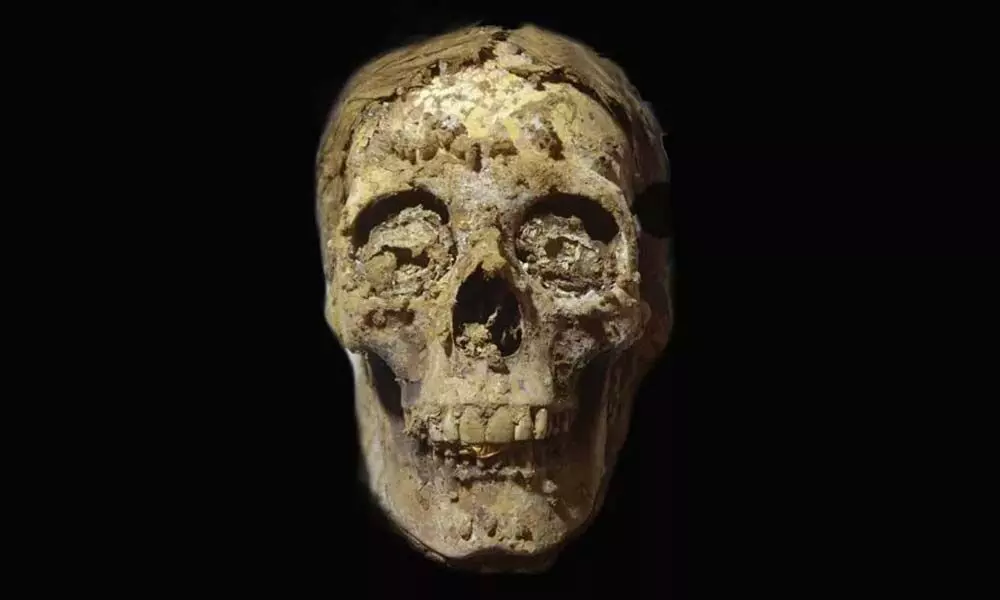Live
- Lokesh lambasts Jagan for imposing a burden of Rs 6,500 cr on State govt
- Trans women in India face stigma, depression, anxiety, and suicidal thoughts: Study
- Mild quake hits Tripura, eighth tremor in NE in less than a month
- Traffic jam at ghat road as devotees throng Srisailam temple
- NDA govt neglecting edu sector, flays Jagan
- No country in world matches India's zeal for knowledge: Yogi
- Special trains for Ayyappa devotees
- Didn’t expect win margin to be so huge: BJP’s Ramveer
- Am I Pregnant? Symptoms to look out for
- iOS 19 and LLM Siri Delayed Until April 2026: What to Expect
Just In
Mummy With a Gold - Foil Tongues Discovered In Egypt

Hans News Service | 15 Dec 2021 5:15 PM IST

x
The ancient Egyptian man's skull and jawbone still contained the gold-foil tongue. (Image credit: Egyptian Ministry of Tourism and Antiquities)
Highlights
- According to the Egyptian Ministry of Tourism and Antiquities, archaeologists unearthed the bones of three ancient Egyptians a man, woman, and kid who were supplied with gold foil tongues
- The man's grave, however, dates from the 26th dynasty (664 B.C. to 525 B.C. ), commonly known as the Saite period.
According to the Egyptian Ministry of Tourism and Antiquities, archaeologists unearthed the bones of three ancient Egyptians a man, woman, and kid who were supplied with gold foil tongues, a treasure likely intended to enable them communicate with gods in the afterlife.
The graves were discovered in two nearby tombs. As per Ahram Online, one of the tombs, that had been looted by grave robbers, held the remains of the woman and a 3-year-old child and also had a limestone sarcophagus with a lid moulded like a woman. The man's grave, however, dates from the 26th dynasty (664 B.C. to 525 B.C. ), commonly known as the Saite period.
Esther Pons Mellado, co-director of the archaeological mission of Oxyrhynchus expressed its importance as it's uncommon to come across a tomb that has been completely shut. The discovery was uncovered in the archaeological site of Oxyrhynchus, close the modern town of El Bahnasa, about 100 miles (160 kilometres) south of Cairo, by researchers with the Archaeological Mission of Oxyrhynchus. Based on the mission's website, Oxyrhynchus was the capital of Upper Egypt's 19th nome, or region. The Oxyrhynchus papyri, or ancient Greek, Latin, and various languages inscribed on hundreds of thousands of papyri dating from the third to seventh centuries A.D., are well-known.
Archaeologists found three gold-foil tongues belonging to an ancient Egyptian man, woman and child. (Image credit: Egyptian Ministry of Tourism and Antiquities)
The two newly discovered tombs add to the history of the historic capital. According to The National, the man's tomb contained a mummy placed beneath a limestone sarcophagus with a man-shaped lid, as well as four canopic jars used to house the deceased's organs, amulets along with a scarab, green beads, and roughly 400 ushabti, or glazed ceramic funeral figures.
The man, mother, and child's identities remain unknown, but archaeologists are optimistic that ongoing excavations may yield additional information. Archaeologists have discovered gold tongues in ancient Egyptian graves for the second time this year.

Next Story
More Stories
ADVERTISEMENT
© 2024 Hyderabad Media House Limited/The Hans India. All rights reserved. Powered by hocalwire.com






